|
|
|
|
Contact:
Volkswagen Tire Sizing

| Wheels and Tires Index | |||
| Bolt Patterns and Offset | |||
| Tire Sizing | ←You are Here | ||
| Tire Size Calculator | |||
| Wheels | |||
| Torsion Bar Indexing | |||
| Lengthened Trailing Arms | |||
Note that the tire sizing conventions used over the years by car and tire manufactures leave much to be desired. The following information are basic guidelines only and you will have to consider that any tire change you make to your vehicle will likely cause your auto to perform differently than the stock vehicle did. Older Volkswagens are also dangerous compared to just about any mass produced auto marketed in the US today. Life is also inherently dangerous. Use the following information at your own risk.
This will calculate out the mathematical measurements of a given tire size. Note that the true tire size will differ and is generally less than the calculated size - but not always.
| What size do you have now? | |
What
size would you like to run (optional)? |
Example | |||||||
|
/ R |
|
/ R |
P-Metric 215/75 R15 |
|||||||
|
OR |
OR |
|||||||||
| Width:" Rim:" | Low Profile: |
(last digit not a 0) |
Width:" Rim:" | Low Profile: |
(last digit not a 0) |
Numeric 7.00 x 15 |
||||
|
OR |
OR |
|||||||||
| Height:" Width:" Rim:" | Height:" Width:" Rim:" | Light Truck 30" x 9.50" R15 |
||||||||
|
|
||||||||||
|
Results |
||||
| Measurements | Current Tire |
New Tire |
Difference | Percent Change |
| Sidewall Height (inch): | ||||
| Section Width (inch): | ||||
| Overall Diameter (inch): | ||||
| Circumference (inch): | ||||
| Revs per mile: | ||||
| Sidewall Height (cm): | ||||
| Section Width (cm): | ||||
| Overall Diameter (cm): | ||||
| Circumference (cm): | ||||
| Revs per kilometer: | ||||
| If your speedometer was correct and reads: | You're going approximately: |
Tire Size
Tire size gives you a general idea of what the tire width and diameter are going to be, but the stated size varies to some extent given your wheel width and tire model. Tires can easily be1-2 inches smaller than their stated size. And to make things more confusing, there are actually several tire sizing systems currently used, which can make size calculating more difficult.
Your best bet is to refer the the manufacture's data sheets for the true size of tires and you should not depend on the stated size on the sidewall of the tire if it is important for you to know the actual size of the tire you plan to run. The following table gives you the manufacture's state true measurement of the BF Goodrich AT tires for 15 inch rims.
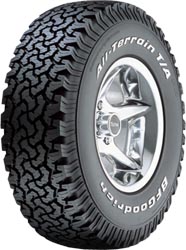
BF Goodrich AT Tires
| Tire Size | Rim
Width Range (inches) |
Section Width on Measuring Rim Width |
Overall Diameter |
Revs/Mile at 45 mph |
Max
Load (lbs@psi) |
| LT195/75 R14 | 5 - 6 | 7.72 on 5.5 | 25.51 | 815 | 1710@65 |
| LT215/75 R15 | 5.5 - 7 | 8.4 on 6 | 27.8 | 748 | 1765@50 |
| LT235/75 R15 | 6 - 7 | 9.1 on 6.5 | 29 | 717 | 1985@50 |
| 30 x 9.50 R15 | 6.5 - 8.5 | 9.4 on 7.5 | 29.5 | 705 | 1990@50 |
| 31 x 10.50 R15 | 7 - 9 | 10.5 on 8.5 | 30.7 | 677 | 2250@50 |
| 32 x 11.50 R15 | 8 - 10 | 11.4 on 9 | 31.7 | 656 | 2530@50 |
| 33 x 10.50 R15 | 7 - 9 | 10.6 on 8.5 | 32.7 | 636 | 2620@50 |
| 33 x 12.50 R15 | 8.5 - 11 | 12.4 on 10 | 32.7 | 636 | 2225@35 |
| 33 x 9.50 R15 | 6.5 - 8.5 | 9.5 on 7.5 | 32.7 | 636 | 2510@50 |
| 35 x 12.50 R15 | 8.5 - 11 | 12.7 on 10 | 34.7 | 599 | 2555@35 |
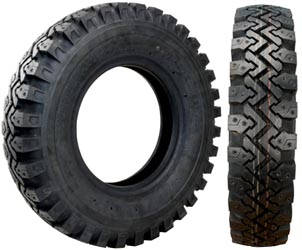
Yokohama Y720 Traction Tire
| Tire Size | Rim Size (inches) | Inflated Dimensions | Capacity at Cold | ||
| Meas. | Alt. | Overall Width (inches) |
Overall Diameter (inches) |
LB/PSI | |
| 7.00-15 | 5.5 | 5.0 - 6.0 | 8.1 | 30.3 | 1720@45 |
What if you don't have the manufacture's size chart like the one above? You can calculate the tire size with as simple equation or use a tire size calculator such as the really nice one above in the Tire Size Calculator section.
Sizing Schemes
Over the years, the design of tires and auto suspensions has changed and generally allowed for improved handling and safety. And with these these advancements, the tire sizes and sizing systems have also changed. If you look at the vintage cars of yesterday, you'll notice that the tires that were originally used are narrower than most OEM tires used today. You may also notice that there was not as much variability in sizes or width/height proportions, which allowed for a much simpler sizing system.
As tire compounds and designs improved, so did auto suspension technology. The combination of both improvements allow newer autos to handle much better than their predecessors, but required more tire sizing options and therefore a more flexible sizing system.
Tire size is really made up of a few measurements. Those most useful for most drivers are Tire Diameter (height of tire), tire width and rim size. There are also several other measurements that play into fitment and gearing, as shown above, but are generally not of a concern to most motorists. Unfortunately these measurements are generally the measurements seen on the sidewall of a given tire.
Most sizing systems in fact use the aspect ratio as prime measurement or scale for the tire size. The aspect ratio is the percentage of the sidewall height compared to the width of the tire. The greater the aspect ration the skinner the tire appears in relation the width. Autos in the 1940s used tires with higher aspect ratios than generally used on more modern autos. In fact, the 90 series tires used about a 92 aspect ratio and accounted for the narrower tires of that time period.
Aspect ratio is important as it has a significant impact on how a tire and auto suspension handles turns and hard impacts. The greater the aspect ratio for a given tire width, the better the tire is able to absorb shocks from bumps, rocks and jumps. Unfortunately, an increase in aspect ratio also causes greater sidewall distortion when the auto corners or negotiates windy roads. You can get an idea of how this works in the image below.
.
Aspect Ratio Comparison when Cornering
The lower the aspect ratio the lower the tire's profile and the better your steering responsiveness. These lower profile tire will also have a greater contact patch on the road surface than higher profile tires with the same tire width and therefore greater traction.
So with aspect ratio, tire width and rim size, you can determine the sectional height (sidewall height), overall tire diameter and most other commonly used tire dimensions. To determine sectional height, divide the aspect ratio by 100 and multiply by the tire width. To get the tire diameter, multiply the sectional height by 2 and add the rim diameter.
Now that we understand these basics we can talk about the most common tire sizing systems used.
Numeric Tire Sizes
This sizing system made sense back when tire size options were limited and much more simplified. It was used in the USA from 1940 to 1970 for OEM tire sizes in the US. Back then, tires were generally narrower than the modern P-metric tires seen on most autos these days and the metric system didn't make a whole lot of sense to Americans. This system is still around for those with vintage cars and is a source of confusion for those looking to maximize tire sizing and fitment but have not idea how this sizing system works.
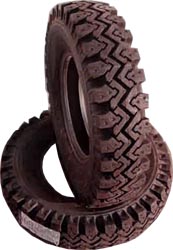
Yokohama Y720 Traction Tire
The Numeric Tire Sizing System is made up of two numbers and possibly some letters. Baja users often refer to 7.00x15 tires which are narrow width 29.5 inch (plus or minus 1 inch) tire and a tad taller than the wider P235/75R15. Since the VWs are designed to run narrow width stock wheels and tires, this tire size gives good ground clearance while fitting on on the stock rims made by VW. The Yokohama Y720 Traction Tire is 29.8" tall, 7.8" wide and is commonly used on the front of limited class buggies, and Baja bugs. The Yokohama Y742S is another popular 7.00x15 tire option for looking for a radial tire.
Between 1940 and 1970, there were two main series of tires. The 90 series tire had an aspect ratio of 92 and the the lower profile 80 series had an aspect ratio of 82. Tire widths ending with a zero, such as the 7.00x15, were 90 series tires. Tire widths ending in something other than a zero, such as a 8.25x15 were 80 series tires.
Note that in 1965, some tires dropped the decimal point in the first number (7.00 = 700).
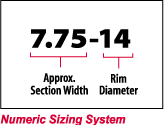
So how can you tell that a 7.00 x 15 is around 30 inches tall? One option is to break down the numbers and do a little calculating.
So for a 7.00 x 15 tire
The Width ends with .00 so it should have a 92 Aspect Ratio
7.00 x 0.92 gives you the height sidewall in inches (tire width divided by aspect ratio) = 6.4 inches
6.4 x 2 gives to the height of the sidewall above and below the wheel = 12.8 inches
12.8 + 15 gives you the height of the tire sidewall above and below the wheel and the wheel diameter, or the total height of the tire = 27.8 inches (actual tire is just over 29 inches so it's in the ballpark)
the 7.00 means that it is 7 inches wide
the 15 means that it fits on a 15 inch rim
Approximate Numeric Tire Sizes
|
Size |
Diameter |
Cross Section |
|
Size |
Diameter |
Cross Section |
|
5.20-10 |
19.90 |
5.55 |
|
185/70R15 |
25.71 |
7.30 |
|
5.50-12 |
21.90 |
5.50 |
|
400/425-15 |
23.00 |
4.70 |
|
155HR13 |
22.80 |
6.50 |
|
5.00-15 |
24.40 |
4.75 |
|
185HR13 |
25.00 |
7.10 |
|
5.60-15 |
25.90 |
4.38 |
|
5.20-13 |
22.80 |
5.65 |
|
5.90-15 |
25.40 |
5.90 |
|
5.60-13 |
23.70 |
5.90 |
|
6.40-15 |
26.90 |
6.25 |
|
5.90-13 |
24.10 |
6.60 |
|
6.70-15 |
27.40 |
7.00 |
|
6.00-13 |
23.70 |
6.20 |
|
7.00-15 |
29.20 |
7.35 |
|
6.40-13 |
25.10 |
6.60 |
|
7.10-15 |
28.00 |
7.40 |
|
6.50-13 |
24.70 |
6.70 |
|
7.75-15 |
27.40 |
7.70 |
|
7.00-13 |
25.70 |
7.10 |
|
7.60-15 |
28.70 |
7.90 |
|
7.25X13 |
25.70 |
7.10 |
|
8.00-15 |
29.08 |
8.30 |
|
6.70/7.25-13 |
25.70 |
7.40 |
|
8.15-15 |
28.66 |
7.90 |
|
7.50-13 |
25.80 |
7.60 |
|
8.20-15 |
29.60 |
8.50 |
|
205VR14 |
26.80 |
8.10 |
|
890-15 |
31.00 |
9.30 |
|
5.20-14 |
24.20 |
5.40 |
|
185X16 |
27.90 |
7.10 |
|
5.90-14 |
25.30 |
6.10 |
|
475/500-16 |
24.13 |
3.94 |
|
6.95-14 |
25.90 |
7.00 |
|
500/525-16 |
26.80 |
5.00 |
|
7.00-14 |
26.50 |
7.00 |
|
5.50-16 |
26.90 |
5.25 |
|
7.50-14 |
27.30 |
7.40 |
|
6.00-16 |
26.36 |
6.25 |
|
7.75-14 |
26.70 |
7.75 |
|
6.50-16 |
29.30 |
6.80 |
|
8.00-14 |
27.60 |
8.10 |
|
7.50-16 |
31.45 |
8.20 |
|
8.25-14 |
25.80 |
8.05 |
|
8.25-16 |
32.45 |
8.80 |
|
8.50-14 |
28.10 |
8.35 |
|
4.50-17 |
25.35 |
4.70 |
|
9.00-14 |
28.70 |
8.80 |
|
5.50-17 |
28.13 |
5.25 |
|
155HR15 |
24.80 |
6.10 |
|
7.00-17 |
31.12 |
7.38 |
|
175/70HR15 |
24.85 |
6.90 |
|
7.50-17 |
31.75 |
8.00 |
|
180HR15 |
26.80 |
6.90 |
|
|
|
|
Alpha Numeric
In 1968, a newer tire sizing system was introduced. The Alpha Numeric system is a load-based system that categorized tires but their size as well as their load carrying capacity with the letter A - N for passenger cars. Truck and Severe Use Duty tires used sizes O - S. The earlier the letter in the alphabet the smaller the tire and the lower the load rating. Only two numbers are included, the aspect ratio and the rim diameter.
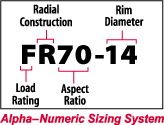
The following charts will give the an idea of what many tires with alpha numeric sizes measure out in actual life. The true tire sizes vary considerably from tire design to tire design.
| Description | Overall diameter | Tire Width | Design Rim Width |
| A78-14 | 24.16 | 6.45 | 4.50 |
| B78-14 | 24.70 | 6.65 | 4.50 |
| C78-14 | 25.24 | 7.05 | 5.00 |
| D78-14 | 25.50 | 7.35 | 5.00 |
| E78-14 | 26.00 | 7.65 | 5.50 |
| F78-14 | 26.50 | 7.90 | 5.50 |
| G78-14 | 27.06 | 8.35 | 6.00 |
| H78-14 | 27.76 | 8.70 | 6.00 |
| J78-14 | 28.20 | 8.80 | 6.00 |
| Description | Overall diameter | Tire Width | Design Rim Width |
|
C70-14 |
24.90 |
7.45 |
5.00 |
|
D70-14 |
25.32 |
7.85 |
5.50 |
|
E70-14 |
25.76 |
8.05 |
5.50 |
|
F70-14 |
26.24 |
8.30 |
5.50 |
|
G70-14 |
26.82 |
8.75 |
6.00 |
|
H70-14 |
27.50 |
9.10 |
6.00 |
|
J70-14 |
26.44 |
9.50 |
6.50 |
|
L70-14 |
28.32 |
9.75 |
6.50 |
| Description | Overall diameter | Tire Width | Design Rim Width |
| D60-14 | 24.44 | 8.65 | 6.00 |
| E60-14 | 24.78 | 9.10 | 6.5 |
| F60-14 | 25.28 | 9.55 | 7.0 |
| G60-14 | 25.80 | 9.85 | 7.0 |
| H60-14 | 26.40 | 10.25 | 7.0 |
| J60-14 | 26.70 | 10.45 | 7.00 |
| L60-14 | 27.20 | 11.10 | 8.00 |
| Description | Overall diameter | Tire Width | Design Rim Width |
| F50-14 | 24.32 | 10.20 | 7.00 |
| H50-14 | 25.36 | 11.35 | 8.00 |
| M50-14 | 26.48 | 12.55 | 9.00 |
| N50-14 | 26.84 | 12.85 | 9.00 |
| Description | Overall diameter | Tire Width | Design Rim Width |
| A78-15 | 24.80 | 6.35 | 4.50 |
| B78-15 | 25.38 | 6.55 | 4.50 |
| C78-15 | 25.82 | 6.95 | 5.00 |
| D78-15 | 26.24 | 7.15 | 5.00 |
| E78-15 | 26.64 | 7.35 | 5.00 |
| F78-15 | 27.22 | 7.70 | 5.50 |
| G78-15 | 27.68 | 8.05 | 5.50 |
| H78-15 | 28.36 | 8.55 | 6.00 |
| J78-15 | 28.72 | 8.70 | 6.00 |
| L78-15 | 29.30 | 8.85 | 6.00 |
| M78-15 | 29.68 | 9.35 | 6.50 |
| N78-15 | 30.16 | 9.80 | 7.00 |
| P78/15 | 32.7 | 8.5 | 7 |
| Q78/15 | 35.5 | 9.2 | 7 |
| R78/15 | 37 | 12.5 | |
| P78/16 | 33.2 | 8.7 | 6.5 |
| Q78/16 | 35.5 | 9.2 | 6.5 |
| R85/15 | 37 | 9.3 | 8 |
| R85/16 | 37 | 9.3 | 8 |
| Description | Overall diameter | Tire Width | Design Rim Width |
|
A70-15 |
24.68 |
6.60 |
4.50 |
|
C70-15 |
25.58 |
7.50 |
5.50 |
|
D70-15 |
26.02 |
7.70 |
5.50 |
|
E70-15 |
26.40 |
8.10 |
6.00 |
|
F70-15 |
26.92 |
8.35 |
6.00 |
|
G70-15 |
27.46 |
8.60 |
6.00 |
|
H70-15 |
28.10 |
8.95 |
6.00 |
|
J70-15 |
28.44 |
9.35 |
6.50 |
|
K70-15 |
28.68 |
9.40 |
6.50 |
|
L70-15 |
28.92 |
9.60 |
6.50 |
| Description | Overall diameter | Tire Width | Design Rim Width |
|
B60-15 |
24.38 |
7.80 |
5.50 |
|
C60-15 |
24.76 |
8.25 |
6.00 |
|
E60-15 |
25.50 |
8.70 |
6.00 |
|
F60-15 |
25.94 |
9.20 |
6.50 |
|
G60-15 |
26.44 |
9.70 |
7.00 |
|
H60-15 |
27.08 |
10.05 |
7.00 |
|
J60-15 |
27.40 |
10.25 |
7.00 |
|
L60-15 |
27.86 |
10.50 |
7.00 |
| Description | Overall diameter | Tire Width | Design Rim Width |
| B50-15 | 23.58 | 8.55 | 6.00 |
| G50-15 | 25.46 | 10.35 | 7.00 |
| H50-15 | 26.06 | 11.15 | 8.00 |
| L50-15 | 26.76 | 11.65 | 8.00 |
| N50-15 | 27.50 | 12.65 | 9.00 |
P-Metric Tire Sizing System
The P-Metric size system is the US version of the metric system established in 1976. The "P" stands for passenger car and means that that tire meets the TRA standards. This sizing system displays section width in millimeters, the aspect ratio, the radial designation, and the rim diameter.
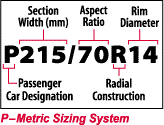
Tire sizes starting with other letters denotes different types of tires.
Metric Tire Size System
This is more or less the same as the P-Metric system and conforms to the ETRTO standards. Like the P-metric system, it lists the sectional width in millimeters, the aspect ratio and the rim diameter. It also lists the load index as a numerical code ranging from 70 to 131. This load index is associated with the maximum load a tire is rated to carry. A higher number indicates higher load capacity.
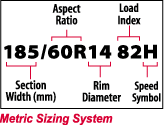
LT Sizing System
These systems are used for light truck tires. One is basically the same as the P-Metric but starts with an LT. The other system lists out the tire diameter and width in inches. It doesn't get much easier than that.
A 30x9.5R15 is a 30 inch tire with a 9.5 inch width for a 15 inch wheel.
Conversion Chart
There are many comparison charts out there and they basically get you in the ball park as you are comparing tires with different aspect ratios and for different cars over the span of many decades of tire evolution.
| Numeric Pre 1965 | Numeric 1965-72 | Alphanumeric 60 Series | Alphanumeric 70 Series | Alphanumeric 78 Series | Metric 80 Series | Modern 60 Series | Modern 70 Series | Modern 80 Series |
|---|---|---|---|---|---|---|---|---|
| 5.50-12, 5.60-12 | 165/60-12 | 165/70-12 | 155/80-12 | |||||
| 6.00-12 | Y78-12 | |||||||
| 5.20-13 | W78-13 | 165/60-13 | 145/70-13 | 135/80-13 | ||||
| 5.60-13 | Y78-13 | 175/60-13 | 155/70-13 | 145/80-13 | ||||
| 6.15-13 | 185/60-13 | 165/60-13 | 155/80-13 | |||||
| 5.90-13 | 600-13 | A60-13 | A70-13 | A78-13 | 165-13 | 195/60-13 | 175/70-13 | 165/80-13 |
| 6.40-13 | 650-13 | B60-13 | B70-13 | B78-13 | 175-13 | 205/60-13 | 185/70-13 | 175/80-13 |
| 6.90-13 | ||||||||
| 7.00-13 | C60-13 | C70-13 | C78-13 | 215/60-13 | 195/70-13 | 185/80-13 | ||
| 7.25-13 | 700-13 | D60-13 | D70-13 | D78-13 | 185-13 | 215/65-13 | 205/70-13 | 195/80-13 |
| 7.75.13 | E60-13 | E70-13 | E78-13 | 195/80-13 | ||||
| 5.20-14 | 165/60-14 | 145/70-14 | 135/80-14 | |||||
| 5.60-14 | 175/60-14 | 155/70-14 | 145/80-14 | |||||
| 5.90-14 | ||||||||
| 6.15-14 | A60-14 | A70-14 | A78-14 | 185/60-14 | 165/70-14 | 155/80-14 | ||
| 6.45-14 | 645-14 | B70-14 | B78-14 | 155-14 | 195/60-14 | 185/70-14 | 175/80-14 | |
| 6.95-14 | 695-14 | C70-14 | C78-14 | 175-14 | 205/60-14 | 195/70-14 | 185/80-14 | |
| D60-14 | D70-14 | D78-14 | ||||||
| 7.00-14 | 735-14 | E60-14 | E70-14 | E78-14 | 185-14 | 215/60-13 | 205/70-14 | 195/80-14 |
| 7.50-14 | 775-14 | F60-14 | F70-14 | F78-14, F83-14 | 195-14 | 225/60-14 | 215/70-14 | 205/80-14 |
| 8.00-14 | 825-14 | G60-14 | G70-14 | G77-14, G78-14 | 205-14 | 235/60-14 | 225/70-14 | 215/80-14 |
| 8.50-14 | 855-14 | H60-14 | H70-14 | H78-14 | 215-14 | 245/60-14 | 235/70-14 | 225/80-14 |
| 8.85-14 | J60-14 | J70-14 | J78-14 | 255/60-14 | 245/70-14 | 235/80-14 | ||
| 9.15-14 | L60-14 | L70-14 | 265/60-14 | 235/70-14 | ||||
| 5.90-15 | 600-15 | A70-15 | A78-15 | 165-15 | 185/60-15 | 175/70-15 | 165/80-15 | |
| 6.35-15 | B60-15 | B70-15 | B78-15 | 195/60-15 | 185/70-15 | 175/80-15 | ||
| 6.50-15 | 685-15 | C60-15 | C70-15 | C78-15 | 175-15 | 205/60-15 | 185/70-15 | 175/80-15 |
| D70-15 | D78-15 | |||||||
| 7.00-15 | 735-15 | E60-15 | E70-15 | E78-15 | 185-15 | 215/60-15 | 205/70-15 | 195/80-15 |
| 7.50-15 | 775-15 | F60-15 | F70-15 | F78-15 | 195-15 | 225/60-15 | 215/70-15 | 205/80-15 |
| 8.00-15, 8.25-15 | 825-15 | G60-15 | G70-15 | G78-15 | 205-15 | 235/60-15 | 225/70-15 | 215/80-15 |
| 8.50-15, 8.55-15 | 855-15 | H60-15 | H70-15 | H78-15 | 215-15 | 245/60-15 | 235/70-15 | 225/80-15 |
| 8.85-15, 8.90-15 | 885-15 | J60-15 | J70-15 | J78-15 | 230-15 | 255/60-15 | 245/70-15 | 235/80-15 |
| 9.00-15 | K70-15 | 265/60-15 | 245/70-15 | 230/80-15 | ||||
| 9.15-15 | 900-15 | L60-15 | L70-15 | L78-15, L84-15 | 235-15 | 255/70-15 | 235/80-15 | |
| M70-15 | M78-15 | 255/80-15 | ||||||
|
N78-15 |
Speed Rating
This is often overlooked by US drivers, but really matters if you plan to take your auto over 75 MPH. Obviously, in Germany, speed rating actually means something since they can legally driver their sports auto faster than 120km/h.
The rating can be found in different places within the tire size. The S in the following tire sizes denotes an S speed rating.
| 225/50SR16 | 225/50SR16 89S | 225/50R16 89S |
Tires used of autos generally range from L to Y. Tires with speed ratings below that are not are not suitable of highway use.
| Code | mph | km/h | Code | mph | km/h | Common Application | |
|---|---|---|---|---|---|---|---|
| A1 | 3 | 5 | L | 75 | 120 | Off-Road & Light Truck Tires | |
| A2 | 6 | 10 | M | 81 | 130 | ||
| A3 | 9 | 15 | N | 87 | 140 | Temporary Spare Tires | |
| A4 | 12 | 20 | P | 94 | 150 | ||
| A5 | 16 | 25 | Q | 100 | 160 | Studless & Studdable Winter Tires | |
| A6 | 19 | 30 | R | 106 | 170 | H.D. Light Truck Tires | |
| A7 | 22 | 35 | S | 112 | 180 | Family Sedans & Vans | |
| A8 | 25 | 40 | T | 118 | 190 | Family Sedans & Vans | |
| B | 31 | 50 | U | 124 | 200 | ||
| C | 37 | 60 | H | 130 | 210 | Sport Sedans & Coupes | |
| D | 40 | 65 | V | 149 | 240 | Sport Sedans, Coupes & Sports Cars | |
| E | 43 | 70 | Z | over 149 | over 240 | Rating made prior to W and Y | |
| F | 50 | 80 | W | 168 | 270 | Exotic Sports Cars | |
| G | 56 | 90 | (W) | over 168 | over 270 | Exotic Sports Cars | |
| J | 62 | 100 | Y | 186 | 300 | Exotic Sports Cars | |
| K | 68 | 110 | (Y) | over 186 | over 300 | Exotic Sports Cars |
Load Rating
The load rating is often found after the size numbers in the tire size of passenger car tires. A P195/60R15 87S would have a load rating of 87.
| Code | Pounds | Kilograms | Code | Pounds | Kilograms | Code | Pounds | Kilograms | Code | Pounds | Kilograms | |||
|---|---|---|---|---|---|---|---|---|---|---|---|---|---|---|
| 60 | 551 | 250 | 80 | 992 | 450 | 100 | 1,764 | 800 | 120 | 3,087 | 1,400 | |||
| 61 | 567 | 257 | 81 | 1,019 | 462 | 101 | 1,819 | 825 | 121 | 3,197 | 1,450 | |||
| 62 | 584 | 265 | 82 | 1,047 | 475 | 102 | 1,874 | 850 | 122 | 3,306 | 1,500 | |||
| 63 | 600 | 272 | 83 | 1,074 | 487 | 103 | 1,929 | 875 | 123 | 3,418 | 1,550 | |||
| 64 | 617 | 280 | 84 | 1,102 | 500 | 104 | 1,984 | 900 | 124 | 3,528 | 1,600 | |||
| 65 | 640 | 290 | 85 | 1,135 | 515 | 105 | 2,039 | 925 | 125 | 3,638 | 1,650 | |||
| 66 | 661 | 300 | 86 | 1,168 | 530 | 106 | 2,094 | 950 | ||||||
| 67 | 677 | 307 | 87 | 1,201 | 545 | 107 | 2,149 | 975 | ||||||
| 68 | 695 | 315 | 88 | 1,235 | 560 | 108 | 2,205 | 1,000 | ||||||
| 69 | 717 | 325 | 89 | 1,279 | 580 | 109 | 2,271 | 1,030 | ||||||
| 70 | 738 | 335 | 90 | 1,323 | 600 | 110 | 2,337 | 1,060 | ||||||
| 71 | 761 | 345 | 91 | 1,356 | 615 | 111 | 2,403 | 1,090 | ||||||
| 72 | 783 | 355 | 92 | 1,389 | 630 | 112 | 2,470 | 1,120 | ||||||
| 73 | 805 | 365 | 93 | 1,433 | 650 | 113 | 2,536 | 1,150 | ||||||
| 74 | 827 | 375 | 94 | 1,477 | 670 | 114 | 2,601 | 1,180 | ||||||
| 75 | 853 | 387 | 95 | 1,521 | 690 | 115 | 2,679 | 1,215 | ||||||
| 76 | 882 | 400 | 96 | 1,565 | 710 | 116 | 2,756 | 1,250 | ||||||
| 77 | 908 | 412 | 97 | 1,609 | 730 | 117 | 2,833 | 1,285 | ||||||
| 78 | 937 | 425 | 98 | 1,653 | 750 | 118 | 2,910 | 1,320 | ||||||
| 79 | 963 | 437 | 99 | 1,709 | 775 | 119 | 2,999 | 1,360 |
Load Range
Load range is used on light truck tires and indicates ply rating and load pressure (PSI).
| Load Range | Ply Rating | Load Pressure (PSI) |
|---|---|---|
| B | 4 | 35 |
| C | 6 | 50 |
| D | 8 | 65 |
| E | 10 | 80 |
| F | 12 | 95 |
Tire Age
If you look carefully at the numbers on your tire, you may find a manufactured date. US law requires that a complete DOT Tire Identification Number be stamped on one side of the tire - often the tire facing away from the road. This number is a combination of the and signifies that it meets all U.S. Federal Motor Vehicle Safety Standards (FMVSS). This number starts with "DOT" and followed by ten, eleven or twelve characters which are used to identify the manufacturing location, tire size and manufacturer's specifications, along with the week and year the tire was manufactured. If you only see a partial DOT ID, you will need to look on the other outer sidewall for the complete number. If no DOT number is identified, that tire is not DOT approved for road use in the US.
The 3 or 4 numbers at the end of the DOT ID is the coded batch week and year the tire was manufactured. The first two digits are week of the year and the third and fourth digits related to to the year of manufacturing. A "2306" means that the tire was made in the 23rd week of 2006. A "448" means the tire was made in the 44th week of the 8th year of the decade (1998, 1988, etc).
Tire longevity has increased over the years and the tires of yesterday just weren't made to last as long as today's tires. Bias ply tires made in the the 1970s typical lasted less than 20,000 miles and were only expected to be in service for about two years. The early radial ply tires of the 1980s had a treadwear expectancy of about 40,000 miles during four years of service. Many of the newer long-life radial tires made around 2000 have extended treadwear expectancy to about 60,000 miles during 4 plus years of service. Tires are now approaching the 80,000 mile mark, which means that the tread life is more likely to outlast the rest of the tire's life.
There is a considerable amount of concern that tires age, even when stored indoors and never used. In the UK, the British Rubber Manufacturers Association (BRMA) issued a statement in June 5, 2001 -"BRMA members strongly recommend that unused tires should not be put into service if they are over 6 years old and that all tires should be replaced 10 years from the date of their manufacture." Many other car and tire manufactures, US and otherwise, have also recommended a 6 year expiration date on tire as there is concern that there may be a danger of catastrophic failure if a tire greater than 6 years is used on the road.
An expiration date certainly has its economic advantages for tire manufactures, but there may also be some real logic surrounding the potential dangers of aged tires. Basically, tires are more complex than they appear and for them to maintain all of their performance features and remain soft, oils are added to the rubber. These oils migrate, under tread and casing over time and evaporate into the air adding to that special tire shop smell. This loss of oil from the tire causes the tire to harden, lose performance and become weaker. If a new tire sits on a back shelf for 10 years, it will continue to age and harden while still appearing brand new. And yes, you can find tire greater than 10 years of age in some reputable tire shops in the US and on many VW that don't get driven much.
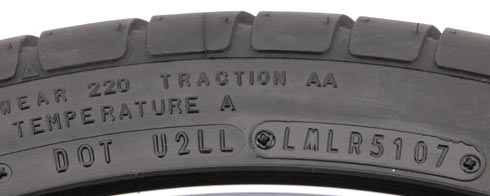
| In example above: | |
| DOT U2LL LMLR 5107 | Complete DOT Identification Number |
| DOT U2LL LMLR 5107 | Manufactured during the 51st week of the year |
| DOT U2LL LMLR 5107 | Manufactured during 2007 |
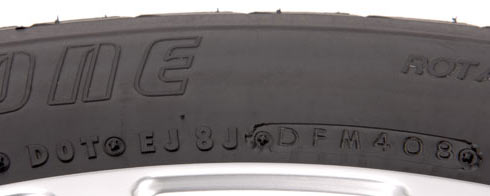
| In example above: | |
| DOT EJ8J DFM 408 | Complete DOT Identification Number |
| DOT EJ8J DFM 408 | Manufactured during the 40th week of the year |
| DOT EJ8J DFM 408 | Manufactured during 8th year of the decade (1998, or 88, etc) |
Ref:
ABC - Aged Tires: A Driving Hazard?
Please feel free to link to this site so that others can find it. It's easy to link to this site, just copy one of the texts below onto your web page::
Copyright © 2000-2010